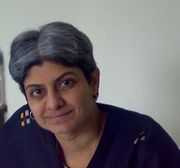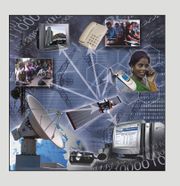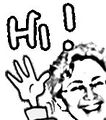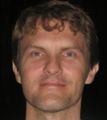User:Sgokhale
| Employer: | Indira Gandhi National Open University, New Delhi, India |
| Occupation: | Teaching |
| Nationality: | Indian India |
| Languages: | Marathi, English, German, Hindi |
| Country: | India |
Contents
My Profile
Professional Background
Working in the Indira Gandhi National Open University as a Physics Teacher for more than a decade. Involved in creation of Distance Learning material for under-graduate and post-graduate programmes.
Also involved in discipline based research in the field of Nanotechnology.
Education
M.Sc. (Physics) [Pune University, India]
Ph.D.(Physics- Materials Science) [Pune University, India]
L.L.M. (Intellectual Property Rights) [Turin University, Italy]
My Interests
Professional
Personal
Photos
My Projects
- (
 : Dear Dr Shubha, is this project you are developing as a free content resource licensed under a CC-BY-SA or CC-BY license which can be used by yourself (and others) on WikiEducator? With best wishes, Ramesh Sharma 12:41, 3 October 2011 (UTC) )
: Dear Dr Shubha, is this project you are developing as a free content resource licensed under a CC-BY-SA or CC-BY license which can be used by yourself (and others) on WikiEducator? With best wishes, Ramesh Sharma 12:41, 3 October 2011 (UTC) )
- (
 : Dear Dr.Sharma, I have replied to your comment on your discussion board.Thanx-Shubha)--Shubha Gokhale, IGNOU, India 07:45, 4 October 2011 (UTC)
: Dear Dr.Sharma, I have replied to your comment on your discussion board.Thanx-Shubha)--Shubha Gokhale, IGNOU, India 07:45, 4 October 2011 (UTC)
A.1.Communication Tools
Introduction
We always communicate with others, may be by directly talking, if the person is nearby or by using modern technological tools, if the person is stationed far away. Communicating with each other is a characteristic of most of the living creatures in the world. The word communication implies that there is some information, which one entity wants to pass on to the other. In the animal kingdom, the communication is used mainly for two purposes:
You must have noticed that these communications are based on mainly four domains in Physics, viz. mechanical, chemical, optical and electrical.
Human beings possess two very strong means of communication. Our mouth (with tongue and throat) has a special structure to produce about 10 vowels and 35 to 40 consonants very distinctly; and thus we, particularly Indians, have come out with phonetic languages. The sounds produced by mouth are heard (sensed) by our ears.
We also use light signals, as we have a very good optical sensor in the form of eyes, but for this, we need some external source of light like the sun, lamps etc. Though we make use of purely mechanical signals for very small distances like tapping on shoulder (direct contact), more often we use opto-mechanical signals like nodding or hand-gestures for calling or by showing a picture. Sometimes direct optical signals are used; e.g. light signals for traffic control. Thus, in general, we use sound (audio frequencies: 20 Hz to 20 kHz) and light (visible: red to violet) as the main modes for non-contact communication.
In audio communication, the information in the form of sound signal reaches our ears as a series of sounds one after the other. This is a serial communication. Our eyes can process a picture or view, which is in 2 or 3 dimensions. That is, it accepts the information in a parallel form. These are the two major modes of information transport in communication.
IIn modern era we use electronic modes of communications. These include elephone, radio, television, cellular mobiles and communication via computers. Though these are different types of communication tools, the basic building blocks of any communication system are broadly the same. There is always a source of signal. This signal is first converted into electrical form and then processed through electronic circuit, in order to make it suitable for transmission. This processed signal is then transmitted through a medium of transmission like free space, metal wire, optical fibre etc. Once the signal reaches the destination, the receiver has a circuit that converts the received signal back into the form which is understood by human perception.
Objectives
After studying this unit, you should be able to:
• describe the various forms of communications in nature;
• explain the basics of human communication;
• distinguish and compare audio (serial) and visual (parallel) signals;
• draw the block diagram of a typical communication system and describe the significance of each block;
• explain the modern communication terminology; and
• list the various media used in communication.
--Shubha Gokhale, IGNOU, India 06:34, 26 September 2011 (UTC)
Communications(Curtsy: Wikipedia via Ravi Limaye)
Communications Media(Curtsy: Wikipedia via Ravi Limaye)
Blog created for this course
Animation showing data transport in computer networks
--Shubha Gokhale, IGNOU, India 07:29, 28 September 2011 (UTC)
Optical Fibre in Communication (Power Point Presentation)
--Shubha Gokhale, IGNOU, India 11:42, 29 September 2011 (UTC)
Assignment
Test Questions
--Shubha Gokhale, IGNOU, India 07:23, 4 October 2011 (UTC)
My Sandbox
My Reflection
Feedback & Notes from my WikiNeighbours
(![]() : Hello Dr Shubha, good to see that you have already started adding content to your page. Best wishes, --R C Sharma, PhD 11:53, 26 September 2011 (UTC))
: Hello Dr Shubha, good to see that you have already started adding content to your page. Best wishes, --R C Sharma, PhD 11:53, 26 September 2011 (UTC))
(![]() : Hi Shubha, You are very welcome to this eL4C51 Online workshop. I am your facilitator and will help you in develop your page. Enjoy this workshop and donot hesitate to ask for help. You can either leave a message on my user page or email me. Warm wishes.--Ramesh Sharma 10:20, 20 September 2011 (UTC))
: Hi Shubha, You are very welcome to this eL4C51 Online workshop. I am your facilitator and will help you in develop your page. Enjoy this workshop and donot hesitate to ask for help. You can either leave a message on my user page or email me. Warm wishes.--Ramesh Sharma 10:20, 20 September 2011 (UTC))
(![]() : Hi Shubha, Greetings! Congratulations for having decided to join eL4C!...and wishing you a very interesting and worthy learning time with the eminent facilitators of our WikiEducator family! Warm regards Anil Prasad 17:59, 24 September 2011 (UTC))
: Hi Shubha, Greetings! Congratulations for having decided to join eL4C!...and wishing you a very interesting and worthy learning time with the eminent facilitators of our WikiEducator family! Warm regards Anil Prasad 17:59, 24 September 2011 (UTC))
 Hi, welcome to eLC51.It's great to be on this course with you. Best regards. --Godfredabledu 07:10, 25 September 2011 (UTC)
Hi, welcome to eLC51.It's great to be on this course with you. Best regards. --Godfredabledu 07:10, 25 September 2011 (UTC)
(![]() : Hi Shubha, Greetings! Warm welcome to WE for joining the workshop. I wish you a very eventful and enhanced learning experience with us. Please start developing your Userpage according to your creativity. The sky is the limit. Warm regards.--Dr. K S Ramakrishnan 17:30, 25 September 2011 (UTC))
: Hi Shubha, Greetings! Warm welcome to WE for joining the workshop. I wish you a very eventful and enhanced learning experience with us. Please start developing your Userpage according to your creativity. The sky is the limit. Warm regards.--Dr. K S Ramakrishnan 17:30, 25 September 2011 (UTC))
![]() Hello, I found nice content on communication on your page, I am putting some link related to your topic --Ravi limaye 19:35, 27 September 2011 (UTC)
Hello, I found nice content on communication on your page, I am putting some link related to your topic --Ravi limaye 19:35, 27 September 2011 (UTC)
Thanks Ravi for providing the links on my project.--Shubha Gokhale, IGNOU, India 06:47, 28 September 2011 (UTC)
(![]() : Hi, you are doing good work, pl keep updating information on your page. Thanks - Ramesh Sharma, PhD 13:25, 1 February 2014 (UTC))
: Hi, you are doing good work, pl keep updating information on your page. Thanks - Ramesh Sharma, PhD 13:25, 1 February 2014 (UTC))
Welcome to eL4C51
- Hello and welcome to eL4C51, a free online Learning4Content wiki skills workshop.
- You may wish to check the schedule of the workshop, introduce yourself, and check the list of participants.
- Whenever you have the time, click on each of the above links and/or start ahead of time with the Pre-Work and Day 1 activities.
- Enjoy the workshop :-)
- Your facilitators:
Hello Dr. Shubha Gokhale, your user page is very informative .Congrats.Veena Dhume.











